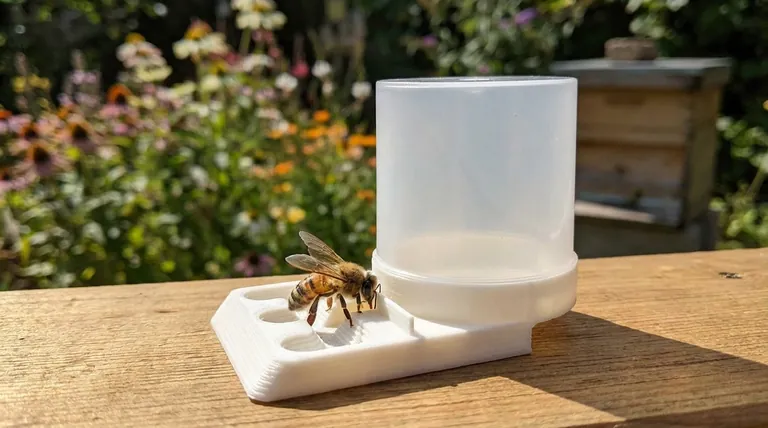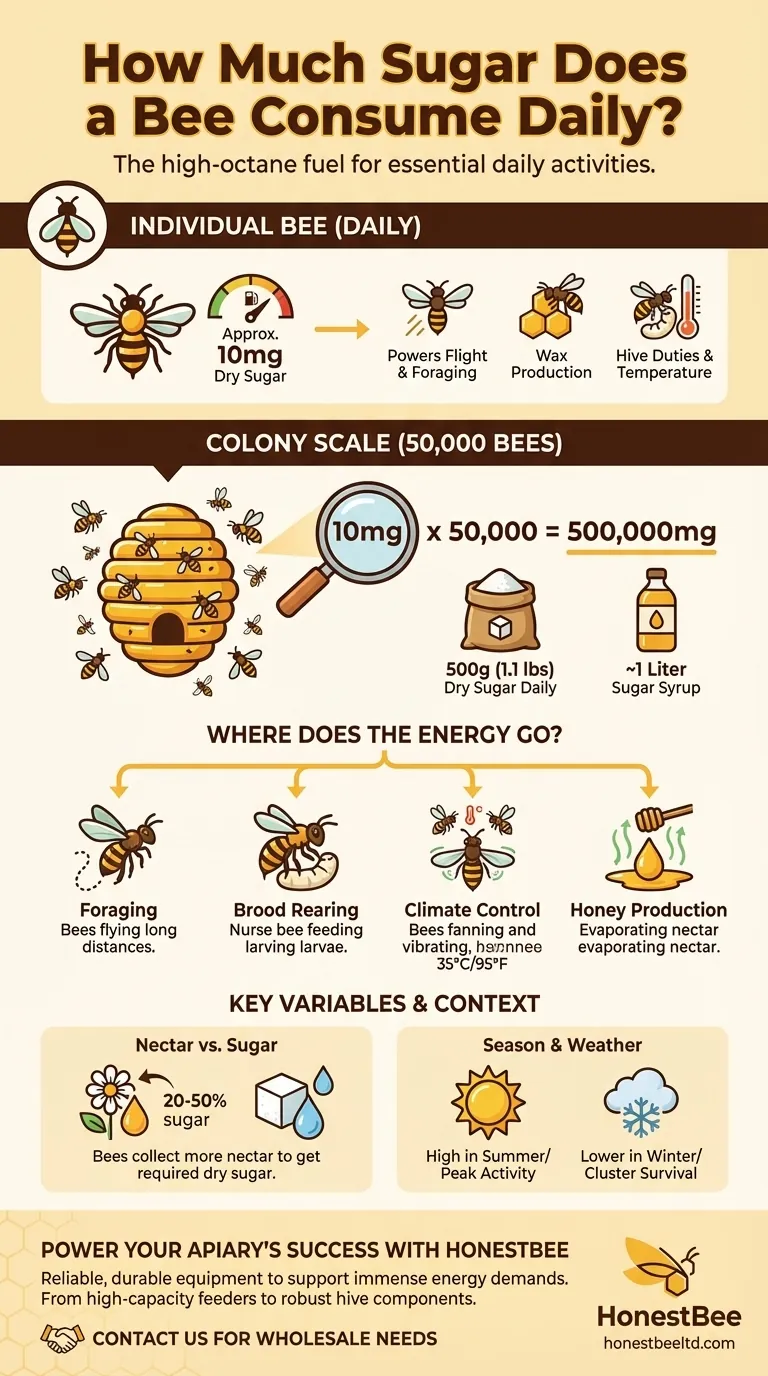On average, an individual honey bee consumes approximately 10 milligrams of dry sugar equivalent each day. This small amount is the high-octane fuel that powers its essential daily activities, from foraging for nectar to maintaining the intricate functions of the hive.
While a single bee's sugar intake seems minuscule, it is the fundamental unit of a colony's massive energy budget. Understanding this helps explain the relentless foraging activity of a hive and its critical need for abundant floral resources.

The Colony's Energy Engine
The true scale of a bee's sugar consumption becomes apparent when you consider the entire colony. A single bee's fuel requirement is just one part of a complex, collective system.
The Individual Bee's Fuel Tank
An individual worker bee's 10mg daily sugar intake powers its incredibly demanding job. This energy is essential for flight, which can cover several miles per foraging trip.
It also fuels in-hive tasks like producing beeswax, tending to the queen and larvae, and regulating the hive's temperature.
Scaling to a Superorganism
A healthy hive in the peak of summer can house 50,000 or more bees. Collectively, their daily sugar need is immense.
Multiplying 10mg by 50,000 bees equals 500,000mg, or 500 grams (about 1.1 pounds) of dry sugar every single day. This is roughly equivalent to the colony consuming an entire liter of sugar syrup daily.
Where Does All the Energy Go?
This colossal energy budget is allocated to several critical colony-wide functions:
- Foraging: Thousands of bees flying millions of cumulative miles.
- Brood Rearing: Feeding and keeping larvae warm requires a stable temperature and constant nourishment.
- Climate Control: Bees expend enormous energy vibrating their flight muscles to generate heat, keeping the hive at a stable 35°C (95°F), regardless of the outside weather.
- Honey Production: Bees must evaporate the high water content from nectar to create honey, a process that requires fanning their wings to create airflow.
Understanding the Key Variables
The "10mg" figure is a strong baseline, but a bee's actual consumption is dynamic and depends heavily on context.
"Dry Sugar" vs. Nectar
Nectar collected from flowers is not pure sugar; it's mostly water. Nectar can range from 20% to 50% sugar content.
This means a bee must collect significantly more than 10mg of nectar to meet its daily sugar requirement. The rest of the weight is water, which the colony must then expend more energy to evaporate.
The Impact of Season and Weather
A bee's metabolism and energy needs fluctuate dramatically. Consumption is highest during the warm, active months of summer when foraging and brood rearing are at their peak.
During cold or rainy days, bees cannot forage. They rely entirely on stored honey to fuel the crucial task of keeping the colony warm. In the depths of winter, the colony forms a tight cluster, consuming honey at a slower but steady rate to survive.
Applying This Knowledge
Understanding a bee's energy needs provides practical insights for different goals.
- If you are a beekeeper: Knowing the colony's daily sugar requirement helps you determine when and how much supplemental syrup to provide during a nectar shortage or in preparation for winter.
- If you are a gardener or naturalist: Recognizing this high energy demand underscores the importance of planting a diverse range of flowers that bloom sequentially, providing a continuous food source for these vital pollinators.
Ultimately, every drop of nectar a bee sips is a deposit into an energy account that powers the pollination of our ecosystems and food crops.
Summary Table:
| Aspect | Key Metric | Context |
|---|---|---|
| Individual Bee (Daily) | ~10mg dry sugar | Powers flight, wax production, and hive duties. |
| Large Colony (50,000 bees) | ~500g (1.1 lbs) dry sugar | Equivalent to roughly 1 liter of sugar syrup per day. |
| Primary Energy Uses | Foraging, Brood Rearing, Climate Control | Essential for colony survival and honey production. |
Power Your Apiary's Success with HONESTBEE
Just as a bee colony relies on a consistent, high-quality fuel source, your commercial operation depends on reliable, durable equipment to thrive. Understanding the immense energy demands of a hive underscores the need for efficient tools and supplies.
HONESTBEE supplies beekeeping supplies and equipment to commercial apiaries and beekeeping equipment distributors through wholesale-focused operations. We provide the essential 'fuel' for your business—from high-capacity feeders that support a colony's daily sugar needs to durable hive components that withstand the elements.
Let's build a more productive and resilient operation together.
Contact HONESTBEE today to discuss your wholesale needs and discover how our equipment can support your colony's health and honey production.
Visual Guide

Related Products
- HONESTBEE Entrance Bee Feeder Professional Hive Nutrition Solution for Beekeeping
- HONESTBEE Round Hive Top Bee Feeder for Syrup
- HONESTBEE Professional Entrance Bee Feeder Hive Nutrition Solution
- In-Hive Dual Compartment Frame Bee Feeder for Targeted Colony Nutrition
- Rapid Bee Feeder White Plastic 2L Round Top Feeder for 8 or 10-Frame Bee Hives
People Also Ask
- How do you make an entrance feeder for bees? A Guide to Safe & Effective Hive Feeding
- How does the entrance feeder method work? A Guide to Simple But Risky Hive Feeding
- What are the common types of honey bee feeders? Choose the Right Feeder for Your Hive
- What is a common problem with hive front feeders? Avoid Robbing Frenzies and Protect Your Hives
- What is an entrance feeder? A Guide to Its Simple Design and High Robbing Risk



















